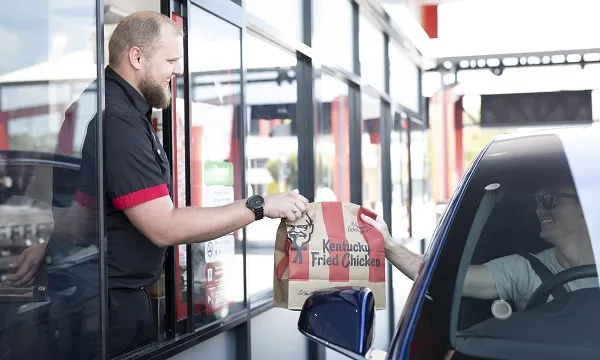
Why mastering the drive-thru segment is crucial, according to KFC, Guzman y Gomez and Zarraffa's Coffee
Executives from three of the biggest chains explain how it is evolving.
What was once a leap toward LED menu boards, speakers and headsets, the drive-thru segment has since become a journey for restaurant brands to take up a digital experience that can start from anywhere - all in the name of convenience and speed.
In separate interviews with QSR Media, executives from KFC, Guzman y Gomez and Zarraffa’s Coffee have made it clear: the segment is a clear growth driver of digital sales, some of which are notably enhanced by voice ordering, pick-up/’click and collect’ service and layout tweaks.
“Customer insights on digital ordering for click and collect or delivery show it has become increasingly popular for hungry Australians with 68 million online food orders made in the country each year, amounting to 7,000 every hour and overall spending $2.6 billion in the last year. Demand for speedy service and efficiency is higher than ever before,” KFC Australia chief development officer Inara Gravitis said.
KFC made headlines at the tail-end of 2019 with their $1.5 million drive-thru only model in Newcastle, another chapter in the fast food brand’s wider tech innovation drive that was preceded by their app and Alexa-powered voice ordering.
Guzman y Gomez meanwhile opened its first drive-thru in 2015, and has since opened at least 24 across the country. Founder and global CEO Steven Marks says it is “undeniable” that drive-thrus are increasingly in demand, with receipts from their drive-thru lanes contributing a “large part to our sales growth.”
“The use of mobile technology is increasingly intersecting with the traditional drive-thru, with cash windows and the need for a cash operator slowly phasing out. Drive-thrus are also starting to accommodate online ordering platforms and allocating lanes specifically for online order pick-ups,” he said.
Zarraffa’s Coffee CEO Marnie Sheldon also saw their brand’s strategy to grow its drive-thru model as a means to curb rising costs in major shopping centres and more customers seeking to-go options.
“Whilst we opened our first drive thru store in 2009, it wasn’t until 2014 that we noticed the consumer shift to more convenience and reoriented our entire business to suit a broader spectrum of coffee-lovers,” she said.

Guzman y Gomez founder & CEO Steven Marks and Zarraffa's Coffee CEO Marnie Sheldon. Photos: Supplied
More volume, more choice
Existing data and target numbers from the brands give additional insight to their growing importance for the drive-thru segment.
KFC discovered that 70% of our customers are ordering through existing drive thrus, with customers going to their app and website and “enjoying the ‘click and collect’ style of ordering.” Their app, specifically, has been downloaded more than 1.3 million times since launching in 2013.
Whilst the average investment is much higher than Guzman y Gomez’s traditional store, the chain says its drive-thrus produce a higher average unit volume, with revenue from drive-thru being one of their “fastest growing formats.” Their aim? Serving 80 cars an hour, with up to 450 transactions.
“Mastering the drive-thru segment is crucial for GYG,” Marks said.
Zarraffa’s says almost 65% of our stores are now drive-thru sites, with plans to only open the said formats in new locations, aimed to give better return on investment to franchisees with “longer leases and competitive rents.”
“This serves our main customer base better too, who are located in the suburbs and regional areas, providing them with more choice to enjoy their coffee either in a dine-in environment or on-the-go,” Sheldon explained.
“Customers expect greater mobile integration”
On improving their drive-thru services and how the segment will evolve in the next years, Gravitis confirmed during the interview that they are working on two further drive-thru only sites in VIC and SA, with the latter recently opening this month.
“We’re always looking for ways to improve our service and provide delicious meals to our customers in the most convenient and speedy ways. As customer behaviour changes and technology advances we’ll continue to adapt and improve,” she said.
Guzman y Gomez, whose drive-thrus are currently equipped with dual-lane technology and the “Summit” system which measures service times and positions cars accordingly, says it is “reasonable to assume” that more drive-thru lanes will exist to pick-up food, rather than order in it.
With drive-thru models being more cashless and highly automated, Marks added that the chain is working to “really leverage and lead drive-thru technology.”
“Voice will play a huge part in this, rather than ordering via an app. We’ll simply be able to say to our phone on the way home: ‘Hey Google, order my usual family order from GYG Hoxton Park, I’ll be there in 20 minutes.’ and simply drive through to pick up hot, fresh GYG food on the way home. Whilst customers already demand convenience, expectations of what convenience looks like are changing — customers expect greater mobile integration and more personal touch points through digital technology,” he said.
Having drive-thru experience for more than a decade, Zarraffa’s stressed the need to orient all strategies to increase and improve speed of service.
But for Sheldon, food remains at the top of the hill.
“Our biggest innovation though has been in our food offering; introducing new and convenient options at different times of the day, that easily complement a coffee drive-thru order,” she said.
“Whilst we will pursue new innovations in products, equipment and so on, we are backed by 22 years of experience and we know our operations work.”
Roxanne Uy contributed to this report.



























